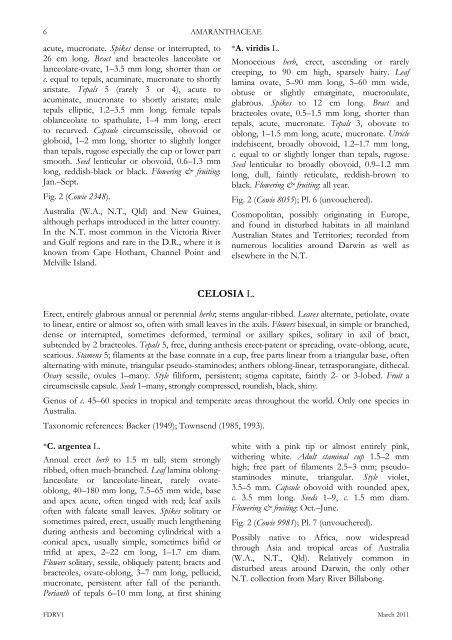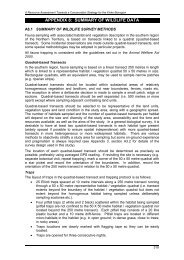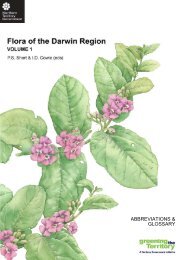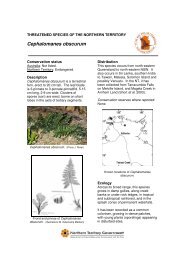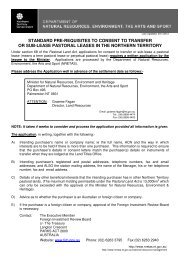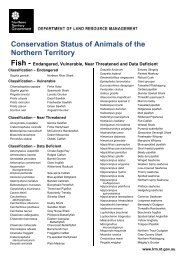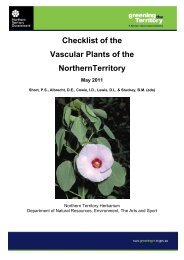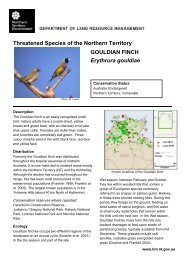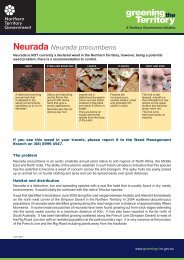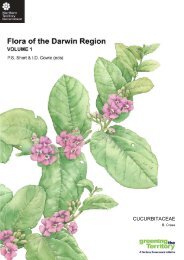AMARANTHACEAE - Department of Land Resource Management ...
AMARANTHACEAE - Department of Land Resource Management ...
AMARANTHACEAE - Department of Land Resource Management ...
Create successful ePaper yourself
Turn your PDF publications into a flip-book with our unique Google optimized e-Paper software.
6<br />
acute, mucronate. Spikes dense or interrupted, to<br />
26 cm long. Bract and bracteoles lanceolate or<br />
lanceolate-ovate, 1–3.5 mm long, shorter than or<br />
c. equal to tepals, acuminate, mucronate to shortly<br />
aristate. Tepals 5 (rarely 3 or 4), acute to<br />
acuminate, mucronate to shortly aristate; male<br />
tepals elliptic, 1.2–3.5 mm long; female tepals<br />
oblanceolate to spathulate, 1–4 mm long, erect<br />
to recurved. Capsule circumscissile, obovoid or<br />
globoid, 1–2 mm long, shorter to slightly longer<br />
than tepals, rugose especially the cap or lower part<br />
smooth. Seed lenticular or obovoid, 0.6–1.3 mm<br />
long, reddish-black or black. Flowering & fruiting:<br />
Jan.–Sept.<br />
Fig. 2 (Cowie 2348).<br />
Australia (W.A., N.T., Qld) and New Guinea,<br />
although perhaps introduced in the latter country.<br />
In the N.T. most common in the Victoria River<br />
and Gulf regions and rare in the D.R., where it is<br />
known from Cape Hotham, Channel Point and<br />
Melville Island.<br />
<strong>AMARANTHACEAE</strong><br />
CELOSIA L.<br />
*A. viridis L.<br />
Monoecious herb, erect, ascending or rarely<br />
creeping, to 90 cm high, sparsely hairy. Leaf<br />
lamina ovate, 5–90 mm long, 5–60 mm wide,<br />
obtuse or slightly emarginate, mucronulate,<br />
glabrous. Spikes to 12 cm long. Bract and<br />
bracteoles ovate, 0.5–1.5 mm long, shorter than<br />
tepals, acute, mucronate. Tepals 3, obovate to<br />
oblong, 1–1.5 mm long, acute, mucronate. Utricle<br />
indehiscent, broadly obovoid, 1.2–1.7 mm long,<br />
c. equal to or slightly longer than tepals, rugose.<br />
Seed lenticular to broadly obovoid, 0.9–1.2 mm<br />
long, dull, faintly reticulate, reddish-brown to<br />
black. Flowering & fruiting: all year.<br />
Fig. 2 (Cowie 8055); Pl. 6 (unvouchered).<br />
Cosmopolitan, possibly originating in Europe,<br />
and found in disturbed habitats in all mainland<br />
Australian States and Territories; recorded from<br />
numerous localities around Darwin as well as<br />
elsewhere in the N.T.<br />
Erect, entirely glabrous annual or perennial herbs; stems angular-ribbed. Leaves alternate, petiolate, ovate<br />
to linear, entire or almost so, <strong>of</strong>ten with small leaves in the axils. Flowers bisexual, in simple or branched,<br />
dense or interrupted, sometimes deformed, terminal or axillary spikes, solitary in axil <strong>of</strong> bract,<br />
subtended by 2 bracteoles. Tepals 5, free, during anthesis erect-patent or spreading, ovate-oblong, acute,<br />
scarious. Stamens 5; filaments at the base connate in a cup, free parts linear from a triangular base, <strong>of</strong>ten<br />
alternating with minute, triangular pseudo-staminodes; anthers oblong-linear, tetrasporangiate, dithecal.<br />
Ovary sessile, ovules 1–many. Style filiform, persistent; stigma capitate, faintly 2- or 3-lobed. Fruit a<br />
circumscissile capsule. Seeds 1–many, strongly compressed, roundish, black, shiny.<br />
Genus <strong>of</strong> c. 45–60 species in tropical and temperate areas throughout the world. Only one species in<br />
Australia.<br />
Taxonomic references: Backer (1949); Townsend (1985, 1993).<br />
*C. argentea L.<br />
Annual erect herb to 1.5 m tall; stem strongly<br />
ribbed, <strong>of</strong>ten much-branched. Leaf lamina oblonglanceolate<br />
or lanceolate-linear, rarely ovateoblong,<br />
40–180 mm long, 7.5–65 mm wide, base<br />
and apex acute, <strong>of</strong>ten tinged with red; leaf axils<br />
<strong>of</strong>ten with falcate small leaves. Spikes solitary or<br />
sometimes paired, erect, usually much lengthening<br />
during anthesis and becoming cylindrical with a<br />
conical apex, usually simple, sometimes bifid or<br />
trifid at apex, 2–22 cm long, 1–1.7 cm diam.<br />
Flowers solitary, sessile, obliquely patent; bracts and<br />
bracteoles, ovate-oblong, 3–7 mm long, pellucid,<br />
mucronate, persistent after fall <strong>of</strong> the perianth.<br />
Perianth <strong>of</strong> tepals 6–10 mm long, at first shining<br />
white with a pink tip or almost entirely pink,<br />
withering white. Adult staminal cup 1.5–2 mm<br />
high; free part <strong>of</strong> filaments 2.5–3 mm; pseudostaminodes<br />
minute, triangular. Style violet,<br />
3.5–5 mm. Capsule obovoid with rounded apex,<br />
c. 3.5 mm long. Seeds 1–9, c. 1.5 mm diam.<br />
Flowering & fruiting: Oct.–June.<br />
Fig. 2 (Cowie 9981); Pl. 7 (unvouchered).<br />
Possibly native to Africa, now widespread<br />
through Asia and tropical areas <strong>of</strong> Australia<br />
(W.A., N.T., Qld). Relatively common in<br />
disturbed areas around Darwin, the only other<br />
N.T. collection from Mary River Billabong.<br />
FDRV1 March 2011


